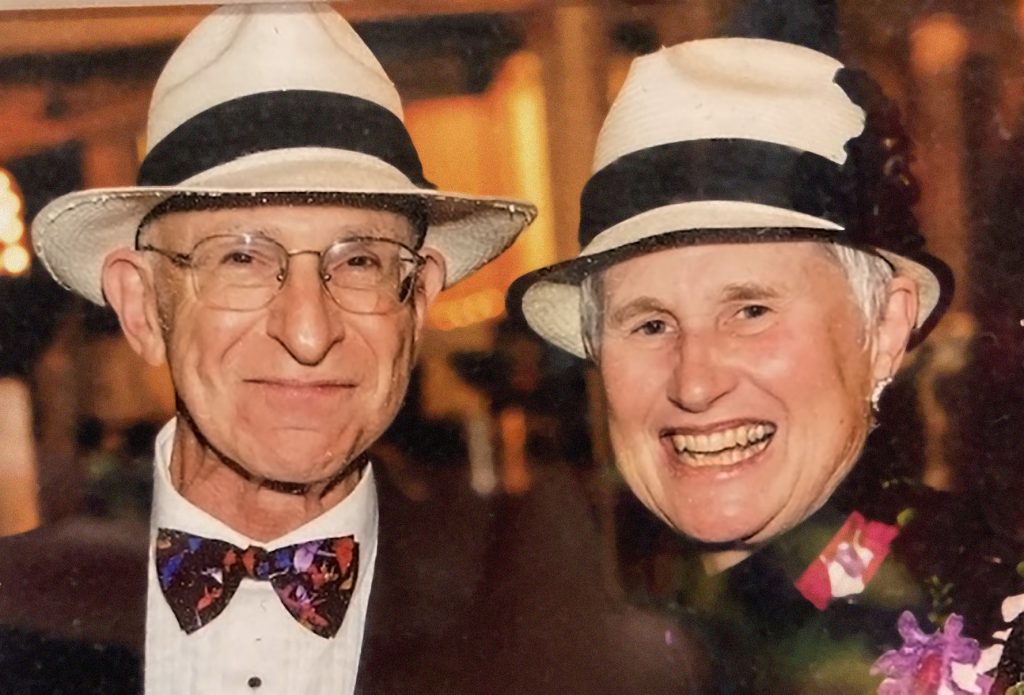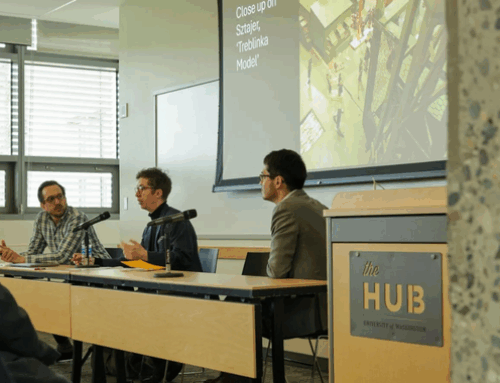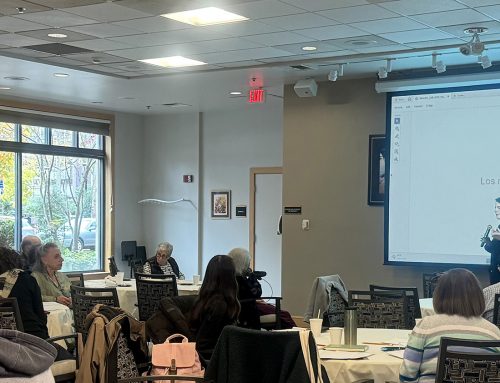
Harvey J. Sadis and Harriett M. Cody
This past year, in the wake of the Sephardic Studies Program’s 10th anniversary, Harvey J. Sadis and Harriett M. Cody, a retired King County Superior Court judge, created the Jean and Joseph Sadis Sustainers Fund in Sephardic Studies as part of the newly launched Sustainers’ Circle, which represents the next stage of philanthropic support for SSP (Sephardic Studies Program).
“This is the largest gift we’ve ever made and will probably be able to make in our lifetime,” said Harriett. “We wanted to be part of a fund that would move support of the Center into the next generation.”
Harvey is a third-generation Sephardic Jew whose grandparents, originally from the island of Rhodes (then part of the Ottoman Empire and today part of Greece) were some of the first Sepharadim to arrive in Seattle in 1911. Harvey’s memory of his mother, Jean, speaking Ladino is the soundtrack to his childhood growing up in Seattle’s Mount Baker neighborhood.
“To me the [Ladino] language is the bedrock of the Sephardic people. Without that they cannot fully express who they are. With the Sephardic Studies Program, I couldn’t be happier that there is a directive to preserve the traditions of Ladino.” — Harvey J. Sadis
Jean Sadis was 102 years old when she passed away in December 2020. A beloved pillar of Seattle’s Sephardic Jewish community, Jean grew up in the Central District, just across the street from the boy who would later become her husband of 63 years, Joe. The couple devoted much of their life to both honoring their ancestral Rhodesli community and helping to build a new generation of community in Seattle as key members of Sephardic synagogue Congregation Ezra Bessaroth in Seward Park.
In March 2021, a public memorial was held (virtually) in Jean’s honor. Isaac Alhadeff Professor of Sephardic Studies, Devin E. Naar, was asked to share his reflections on Jean and the importance of the Sephardic community of which she and Joe were a part of. His words can be found below, and a recording can be found here.
***
Buenas tadres a todos
My name is Devin Naar, and I am the Isaac Alhadeff Professor of Sephardic Studies at the UW.
It is an honor for me to share a few words about Seattle’s Sephardic Jews and the special place that Jean Sadis, de bendicha memoria, played in that story.
For the last several years of her life, Jean was a great friend and supporter of the UW Sephardic Studies program, a program in which Harvey and Harriet have also been actively involved. I am grateful for their friendship and for this opportunity.
Let’s start in the beginning – in 1492 Columbus sailed the ocean blue, and the conquest of the Americas began. That same year, Spanish monarchs King Ferdinand and Queen Isabella expelled the Jews from Spain. Many traversed the Mediterranean and settled in what was then the Ottoman Empire.
Over the generations a very important set of Sephardic Jewish communities developed in the empire’s major cities, Istanbul, Salonica, and Izmir, as well as the island of Rhodes – today in Greece. But for four centuries, the Jews of Rhodes were part and parcel of the Ottoman Jewish world, defined by shared religious practices, music and cuisine, the Ladino language, based on 15th century Castilian with influences from Hebrew, Arabic, Turkuish, Greek, French and Italian.
It is that Ladino language and the community of Rhodes that nurtured Jean Sadis– not over there along the shores of the Aegean, but here by Puget Sound.
In the early part of the 20th century, as the Ottoman Empire experience began to collapse, Jews from across the region began to leave, seeking new opportunities in faraway lands. Asher Tarica, a young man from Rhodes who had been studying agronomy in Cairo, Egypt, left to avoid military service in 1911 as the Ottoman Empire and Italy went to war. He arrived with his bride Sarina Cohen, in New York, and from there headed to Seattle —at the ends of the earth—— where a developing community of Ottoman Jews had begun to set down roots, including some of Sarina’s relatives, and were involved in the fish and produce stands at Pike Place Market.
Asher became deeply involved in Sephardic Jewish community life in Seattle, and numbered among the founders of Congregation Ezra Bessaroth, the synagogue of Rhodesli Jews, first established in Seattle’s Central District. Ladino newspapers published in New York City in the first half of the twentieth century often mention the role of Asher, or as he was later known, ‘Harry’, Tarica in its reportage about communal activities in Seattle.
And it was in Seattle’s Central District where Jean was born and raised, in the heart of the Sephardic community, with the sounds and melodies of Ladino, and aromas and delicious flavors of Sephardic foods and the warmth of family enveloping her.
It would be that same Sephardic community, soon one of the largest and most important in all of the United States, that Jean would dedicate so much of her time and energy, both as a volunteer and as a professional. She served as the president of the Ezra Bessaroth’s Ladies aAuxiliary and became the congregation’s first paid employee, serving as the secretary for many years.
As she moved into such leadership positions, accompanied by her husband Joseph Sadis who also helped reestablish Congregation Ezra Bessaroth in Seward Park, Jean and Joseph began a new chapter ofin their lives in the post-war era, raising their own children — —Harvey and then Linda.
Meanwhile, back on the family’s ancestral island of Rhodes, the conditions had deteriorated. With the onset of the second world war, all the island’s remaining Jews were rounded up and deported by the Nazis—by ship and then by train—to their deaths at Auschwitz.
The reconstituted Sephardic community – and especially the Rhodes community –here in Seattle, its development and thriving over the course of the past hundred years, commemorate the lost ancestral community but also illustrates the dedication of its founding generation and their children – not least of whom was Jean, who played such an important role in that effort over the decades.
It is a thrill for me as the chair of the Sephardic Studies Program to have benefitted from the memories of Jean and her family, and their efforts in ensuring the continued vivacity of Sephardic history, culture, and language in the 21st century. For that alone, we all should be grateful.
Jean Sadis, de bendicha memoria, ke su alma repoze en paz. Amen.
Sanos I rezio ke estesh. Salud I beraha ke tengash.
***
To learn more about the Sephardic Sustainers’ Circle or how you can support the Sephardic Studies Program at the University of Washington, please contact Assistant Director Jennifer McCullum (jemccull@uw.edu).







Leave A Comment